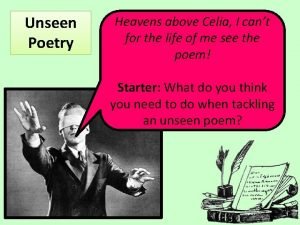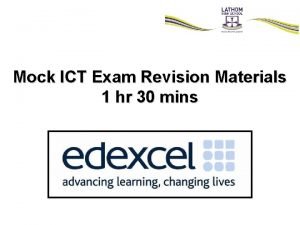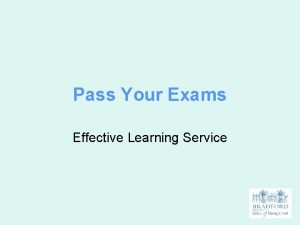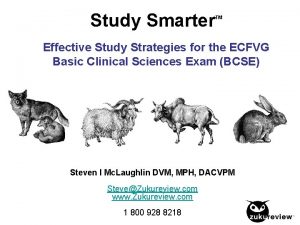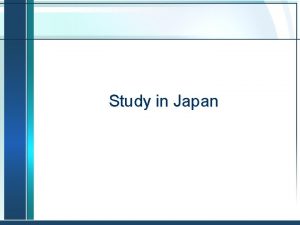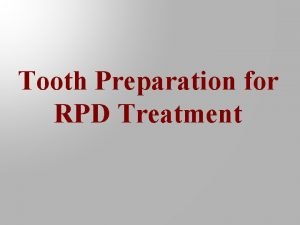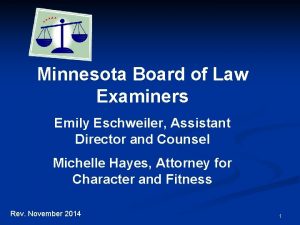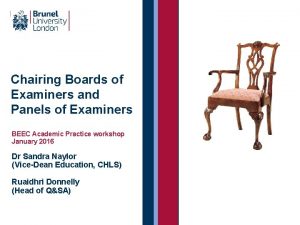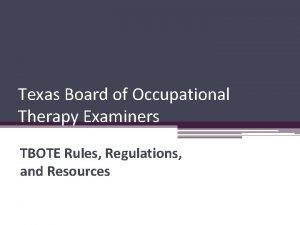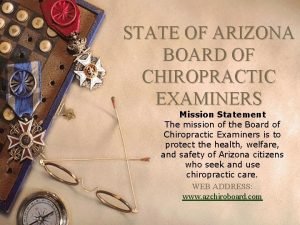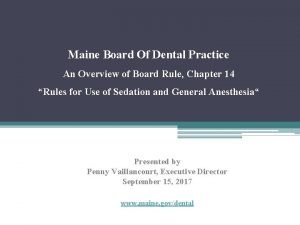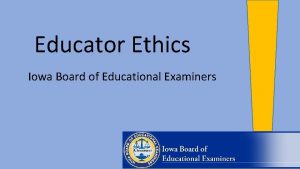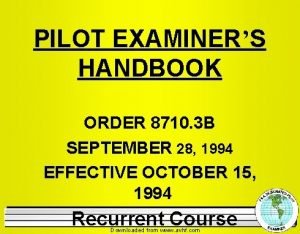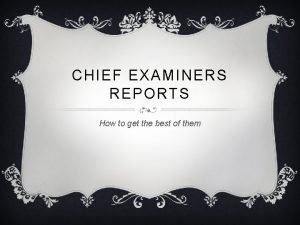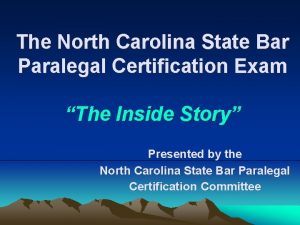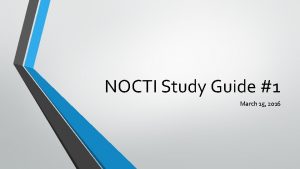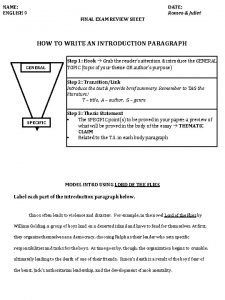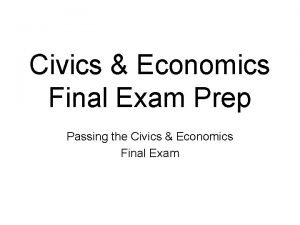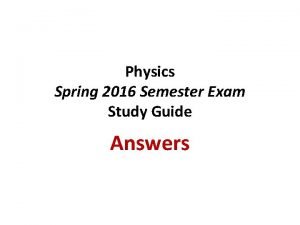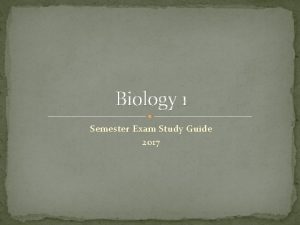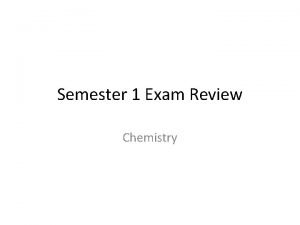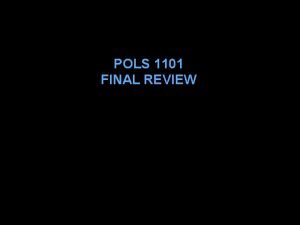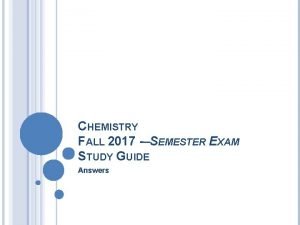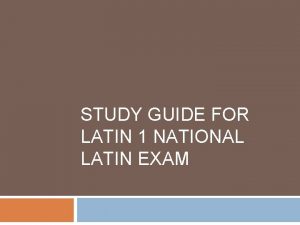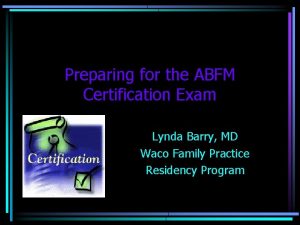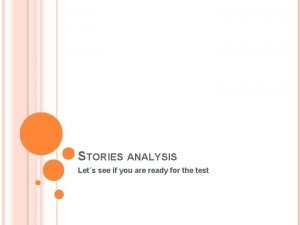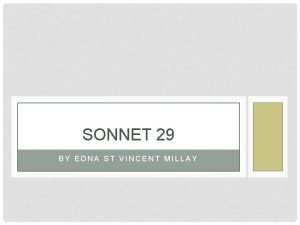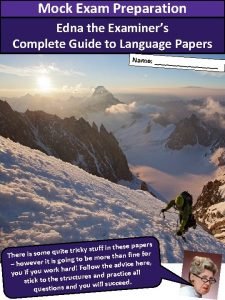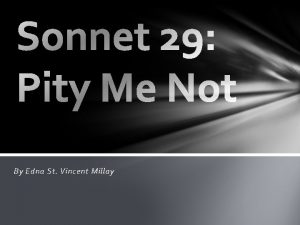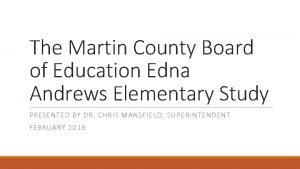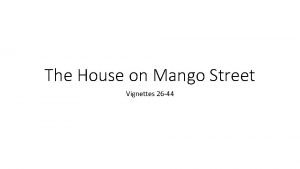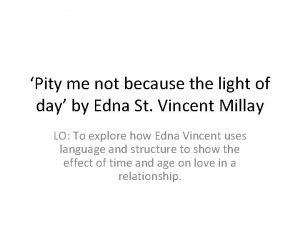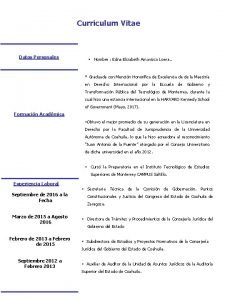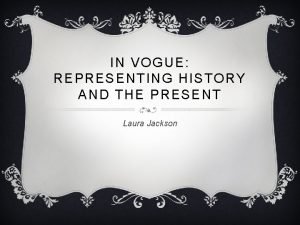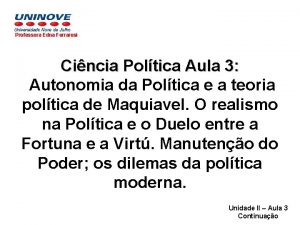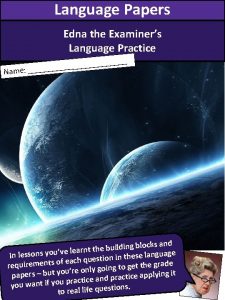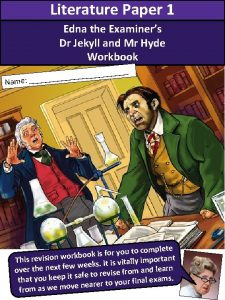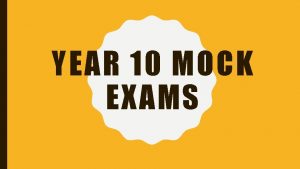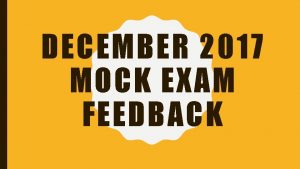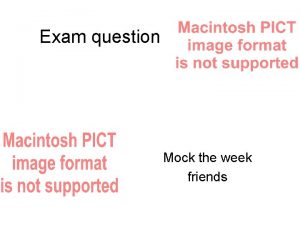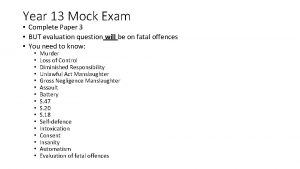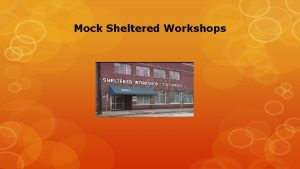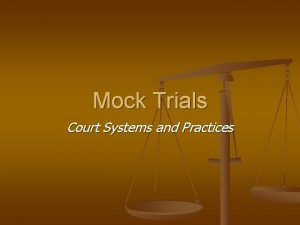Mock Exam Preparation Edna the Examiners Complete Guide
















































- Slides: 48

Mock Exam Preparation Edna the Examiner’s Complete Guide to Language Papers Name: _____ apers p e s e h t n i ff tu s uite tricky There is some q an fine for h t e r o m e b o t oing e here, ic – however it is g v d a e h t w o ll o hard! F you if you work ctice all a r p d n a s e r tu c stick to the stru l succeed. il w u o y d n a s n questio

Language Paper 1 In paper 1, you will be given an extract from a modern narrative (story / nov el) text. This exam is split into two sections… Section A is testing you r reading skills Section B is testing you r writing skills In section A, I want to know if you can: • Take information from a text. • Identify and explain language features • Analyse structural features • Evaluate a text against a statement. In section B, I want to know if you can create interesting texts, using effectively: • Techniques to describe and explain • Paragraphs • Good vocabulary • Punctuation • Spelling In your reading paper your timing is very important. Spend 15 minutes reading the text and then… Question Marks Time % of whole GCSE Extract Information 4 5 mins 2. 5% Language 8 10 mins 5% Structure 8 10 mins 5% Evaluation 20 20 mins 12. 5% Descriptive writing or story writing 24 for content 16 for SPAG 45 mins 25% Look how big a weighting the last two questions are compared to the first tasks – it is vital that you are leaving enough time for these.

Language Paper 1 - Extract Blood on Snow By Jo Nesbo The first thing you need to do is read through the text… The snow was dancing like cotton wool in the light of the street lamps. Aimlessly, unable to decide whether it wanted to fall up or down, just letting itself be driven by the hellish, icecold wind that was sweeping in from the great darkness covering the Oslo fjord. Together they swirled, wind and snow, round and round in the darkness between the warehouses on the quayside that were all shut for the night. Until the wind got fed up and dumped its dance partner beside the wall. And there the dry, windswept snow was settling around the shoes of the man I had just shot in the chest and neck. Blood was dripping down onto the snow from the bottom of his shirt. I don’t actually know a lot about snow – or much else, for that matter – but I’ve read that snow crystals formed when it’s really cold are completely different from wet snow, heavy flakes, or the crunchy stuff. That it’s the shape of the crystals and the dryness of the snow that make the haemoglobin in the blood retain that deep red colour. Either way, the snow under him made me think of a king’s robe, all purple and lined with ermine, like the drawings in the book of Norwegian folk tales my mother used to read to me. She liked fairy tales and kings. That’s probably why she named me after a king. The Evening Post had said that if the cold carried on like this until New Year, 1977 would be the coldest year since the war, and that we’d remember it as the start of the new ice age scientists had been predicting for a while. But what did I know? All I knew was that the man standing in front of me would soon be dead. There was no mistaking the way his body was shaking. He was one of the Fisherman’s men. It was nothing personal. I told him as much before he collapsed, leaving a smear of blood down the wall. If I ever get shot, I’d rather it was personal. I didn’t say it to stop his ghost coming after me – I don’t believe in ghosts. I just couldn’t think of anything else to say. Obviously I could have just kept my mouth shut. That’s what I usually do, after all. So there must have been something that made me so talkative all of a sudden. Maybe it was because there were only a few days to go before Christmas. I’ve heard that people are supposed to feel closer to each other around Christmas. But what do I know? I thought the blood would freeze on top of the snow and end up just lying there. But instead the snow sucked the blood up as it fell, drawing it in under the surface, hiding it, as if it had some sort of use for it. As I walked home I imagined a snowman rising up from the snowdrift, one with clearly visible veins of blood under its deathly pale skin of ice. On the way back to my flat I called Daniel Hoffmann from a phone box to tell him the job was done.

Question 1 Guide Marks: 4 Time: 5 mins Need: 4 sentences Skill: Extracting Information A nice easy question to start with. All I want you to do is extract information from the text… This is only meant to be a quick, snappy one to get you going. Do not spend long on this one at all. Your question will look a bit like this…. Read again the first part of the source from lines 1 to 7. List four things about the snow from this part of the source. (4 marks) Edna’s Top Tips You only need to list what you learn – no PEE paragraphs for th one. is • Use speech marks if you use evidence f rom the text. • Make sure you hav e four different poin ts. • Make sure you are only taking informat ion from the section text asks you to (eg: t the he first 4 lines). • Make sure your an swers are in full sente nces. u re. Edna’s Strategy: As yo ning, Advice from Edward the Examiner read through the ope u learn from AQA highlight anything yo input A lot of students include points that are about the snow. Then, ur not relevant to the question. To avoid these as answers n yo that, I advise you start each sentence exam paper. with the topic from the question. • So, for this question, start each sentence with ‘The snow…. ’

Question 1 – Your Go! Read again the first part of the source from lines 1 to 7. List four things about the snow from this part of the source. (4 marks) A) ____________________________________________________________ B) ____________________________________________________________ C) ____________________________________________________________ D) ____________________________________________________________ q q q Double Check! Have you: Only taken informat ion from the section stated in the question? Checked all your po ints are to do with t he snow? Only listed with no e xplanation? Used speech marks o n quotes? Made four very diffe rent points?

Question 2 Guide Marks: 8 Time: 10 mins Need: 2 – 3 PEEZ paragraphs Skill: Analysing language features Getting a bit more tricky now. This one is about identifying and explaining language features. Remember, this is only meant to take 10 minutes and is just 5% of your GCSE – do not take long on this. Your question will look a bit like this…. Look in detail at this extract. . How does the writer use language here to describe the weather? You could include the writer’s choice of: • Words and phrases • Language features and techniques • Sentence forms • • • (8 marks) Edna’s Top Tips You must, must know your subject termin ology (NAAAMOPSSR question – learn thes ) for this e on the next page. Know the PEEZ struc ture and aim for 3 in 10 minutes. The examiner loves it when you explore th e connotations of key this question – it is v words in ital you get this in you r answer. Edna’s Strategy When you read the extract, underline: • Two or three NAAAMOPSSR technique • One interesting sentence type. Then, write a PEEZ paragraph on each. . These are so important because these will allow you to make points that other people wont. You have to think to yourself, if that is the connotation of this word, then what does that tell me about the weather? Connotations: ideas or images that come to mind from a word. Eg: Connotations of ‘rose’ are love, flowers and thorns.

Question 2 Guide Fill in the table with their definitions. If you want a higher mark, you need to also know what simple, minor, compound and complex sentences are, and further word class other than the ones listed here. Subject Terminology What is it? Noun Adjectives Adverbs Alliteration Metaphor Onomatopoeia Personification Similes Sensory Language Repetition Band Marks Description Simple, limited comment 1 -2 Will make basic points from word choices. Some misunderstandings and repetition of text. Some understanding and comment 3 -4 Will make better interpretations, but will still be limited to one or two features of language. Some interpretations may not be secure. Clear, relevant explanation 5 -6 Will make clear points about the language use – but not all three bullet points. Will not give multiple or extended interpretations. Detailed, perceptive analysis 7 -8 Will pick up on range of words, language features and sentences. Will make points that not everyone else will make (avoid the obvious interpretations!) Will fully explore connotations with multiple and extended interpretations that will be original in places.

Question 2 Guide You need to follow this structure in each paragraph… Point -> Identify a language feature used…. Evidence -> Give a suitable line of evidence Explanation of lead technique-> Explain the effect of the language feature that has been used. Zoom in on a word choice -> Explore the connotations of that word and explain what this tells you about the topic. Below is an example paragraph. Each line has been coloured to match each requirement above. Nesbo uses personification when describing how “the snow was dancing like cotton wool, ” which demonstrates the rhythmic and graceful way that the snow was falling, and indicating how enjoyable it must have been to witness the spectacle. Dancing can also be unpredictable and usually incorporates others, therefore demonstrating how random and unexpected the movements were and the contribution of all the snow flakes in the fall. The noun use of “cotton wool” has connotations of cleanliness and softness, demonstrating the purity of the snow and the peace and calm of the setting. • • This is good because: I’ve used subject terminology where I can. I have been specific and not rambled on. I have embedded my quote. I have extended my interpretations beyond the basic. Edward the AQA Examiner says: The top students will avoid the obvious points and go for the more original and unique ideas that others will not come up with – like this underlined section. Do not settle for basic points like, “this shows the weather is nice” – what better points can you make?

Question 2 - Your go! Look in detail at this extract. The snow was dancing like cotton wool in the light of the street lamps. Aimlessly, unable to decide whether it wanted to fall up or down, just letting itself be driven by the hellish, ice-cold wind that was sweeping in from the great darkness covering the Oslo fjord. Together they swirled, wind and snow, round and round in the darkness between the warehouses on the quayside that were all shut for the night. Until the wind got fed up and dumped its dance partner beside the wall. And there the dry, windswept snow was settling around the shoes of the man I had just shot in the chest and neck. . How does the writer use language here to describe the weather? You could include the writer’s choice of: • Words and phrases • Language features and techniques • Sentence forms (8 marks) ______________________________________________________________________ ______________________________________________________________________ ______________________________________________________________________ ______________________________________________________________________ ______________________________________________________________________


Self-Assess q q Double check, have you: Used subject termin ology each time? Got 2 -3 paragraphs? Not used the most ob vious points? In each paragraph, in cluded: q A point? q Evidence? q Explanation of le ad language choice? q Zoomed in on a key word? Mark Scheme Perceptive, Detailed (7 -8) Shows perceptive and detailed understanding of language • Analyses the effects of the writers choices of language. • Selects a range of judicious quotations • Uses a range of subject terminology appropriately. Clear, relevant (5 -6) Shows clear understanding of language • Clearly explains the effects of writers choices. • Selects relevant quotations • Uses subject terminology accurately. Some, attempts (3 -4) Shows some understanding of language • Attempts to comment on the effect of language • Selects some relevant quotations • Uses some subject terminology, not always appropriately I would give myself _____ marks. To improve next time I need to: In this question, I must remember to:

Question 3 Guide Marks: 8 Time: 10 mins Need: 2 – 3 PEEE paragraphs Skill: Analysing structural choices Now we’re getting really tricky. Analysing structure is not easy… Again, this is only meant to take 10 minutes and is just 5% of your GCSE – do not take long on this. Your question will look a bit like this…. Consider the whole text. How has the writer structured the text to interest you as a reader? You could write about: • What the writer focuses your attention on at the beginning. • How and why the writer changes focus as the source develops. • Any other structural features that interest you. • • • (8 marks) Edna’s Top Tips You must, must know your subject termin ology (REFFSON) for th question – learn thes is e on the next page. Know the PEEE struc ture and aim for 3 in 10 minutes. The examiner loves it when you are examin ing how the structur engages the reader, a e A) nd B) mirrors the char acter or content. See model paragraph as the an example. Edna’s Strategy When you read the extract, split it into three sections (beginning, middle and end). For each section, consider: • Which REFFSON techniques have been applied. How does this engage me as a reader? • How is the overall development of the structure a reflection of the characters thoughts or actions? No structure has just been out together randomly, and I would want my higher students to be able to identify how the structure is representative of the wider plot and character. Mirroring: Just like an image in a mirror, writers can use language and structure to reflect the thoughts and actions of the character.

Question 3 Guide Fill in the table with how the following structural techniques have been used in the text. . Terminolo gy What is it? How has it been used in the text? Repeat What ideas / words have been repeated? Ending What is interesting about the last line? Foreshadowi ng Are there any focuses that foreshadow a later event? Focus What is the main focus of the opening? Why? Sequence How does the focus change throughout the opening? Opening What is interesting about the opening line? Narrative Voice How would you describe the narrative voice? Juxtaposition Are there any focuses that oppose each other? Band Marks Description Simple, limited comment 1 -2 Will make basic points from structural choices. Some misunderstandings and repetition of text. Some understanding and comment 3 -4 Will make better interpretations, but will still be limited to one or two features of structure. Some interpretations may not be secure. Clear, relevant explanation 5 -6 Will make clear points about the structure – but not all bullet points will be covered. Will not give multiple or extended interpretations. Detailed, perceptive analysis 7 -8 Will pick up on range of structural choices. Will make points that not everyone else will make (avoid the obvious interpretations!) Will fully explore how the structural choices mirror the content, with multiple and extended interpretations that will be original in places.

Question 3 Guide You need to follow this structure in each paragraph… Point -> Identify the structural feature(s) used…. Evidence -> Give suitable evidence Explanation -> How has that structural device been used? What is interesting about it? Does the structure mirror the content in any way? Engagement -> Why does that structural technique engage the reader? Below is an example paragraph. Each line has been coloured to match each requirement above. Nesbo focuses on the gentle and pure “cotton wool” like snow at the start of the extract, which puts the reader at a false sense of ease, for the apparently idyllic weather is the setting for a callous murder that the character seems to feel no guilt for. The juxtaposition of the “cotton wool” snow being “driven by the hellish ice-cold wind” in the weather may foreshadow the human being killed by a force of violence and malice, and the clash between the snow and the wind is representative of the conflicting image of the peaceful snow with the bleeding, dead body. To be struck with such a crime so early has the reader questioning the motives and reasons behind it, and for such barbarity to occur against such a pure backdrop means the reader comes to expect shock and horror at any time. Edward the AQA Examiner likes: The fact we worked chronologically – start with the opening, then the middle, and end with the end. The careful consideration of the dual purpose of structure – why does it engage a reader? How does it reflect the wider content? The fact we are not just putting obvious points, but are carefully considering more personal and unique interpretations. The specific explanation of the effect on the reader – do not be general and vague, but specifically examine thoughts and reactions of the reader.



Self-Assess q q Double check, have you: Worked chronologica lly? Got 2 -3 paragraphs? Not used the most ob vious points? In each paragraph, in cluded: q Identification of a structural choice. q Evidence? q Explanation of h ow the device has be en used and if it mirrors the content. q Engagement of t he reader. Mark Scheme Perceptive, Detailed (7 -8) Shows perceptive and detailed understanding of structure • Analyses the effects of the writer’s choice of structural features. • Selects a range of judicious quotations • Uses a range of subject terminology appropriately. Clear, relevant (5 -6) Shows clear understanding of structure • Clearly explains the effects of writers choices of structural features. • Selects relevant quotations • Uses subject terminology accurately. Some, attempts (3 -4) Shows some understanding of structure • Attempts to comment on the effect of structural features • Selects some relevant quotations • Uses some subject terminology, not always appropriately I would give myself _____ marks. To improve next time I need to: In this question, I must remember to:

Question 4 Guide Marks: 25 Time: 20 mins Need: Introduction and 4 PEEZEs Skill: Evaluation This one sounds a lot harder then it really is – if you follow my steps, you’ll be fine! This one is 12. 5% of your whole GCSE and is worth half the reading marks on this paper. It needs your full attention for at least 20 minutes. Your question will look a bit like this…. For this answer, you need to consider the whole text. A reader of this extract said “the murderer, Olav, feels no regret or remorse for the murder he’s committed” To what extent do you agree? In your response, you could: • Consider your own impressions of Olav. • Evaluate how the writer shows that Olav feels no regret or remorse. • Support your response with references to the text. • • • (20 marks) Edna’s Top Tips You must, must know a bank of writer’s methods for this question. As well as the language features and structural features already explored, learn those on the next page as a starting point. Know the PEEZE structure and aim for 4 in 20 minutes. The examiner loves it when you can offer multiple and differing points of view. When you make a point, you need to considering: What else? Can this evidence argue against this too? Are there additional interpretations? • • • Edna’s Strategy Whilst you read through the extract, highlight any evidence to suggest that supports or opposes with your point of view. Then, select the ‘rich quotes’ – the ones that have clear writers methods in them that you can pick out and explain. Start with an introduction give your overall view, considering the text as a whole. All your points going forward will link back to this overall view.

Question 4 Guide In terms of writers choices, you could focus on…. Writer’s Choices What is it? Language Techniques Key words Sentence types Dialogue Structural choices Punctuation Explicit / Implicit Info Tone This one takes a little planning of thought and preparation to do well. First of all, jot down some initial ideas for and against… Reasons to support statement Reasons against statement Introduction: Overall, do you agree or disagree with the statement? In what way? Be as specific as you can.

Question 4 Guide You need to follow this structure in each paragraph… Point and evidence – Make an interpretation and give evidence to support Explanation – what is your personal reflection / impression of the character from the quote chosen? Zoom on writer’s methods – How do the writer’s methods communicate this interpretation? Expand – Can you offer an alternative / additional interpretation from this quote, or is there an additional writer’s method that you can identify? Below is an example paragraph. Each line has been coloured to match each requirement above. Overall, I feel that Olav is trying really hard to not feel regret or remorse and is trying to give the impression to himself and others that he is not bothered by the murder – however he is not as comfortable as he would like to believe. A clear example of this is the peculiar studying of the blood on the snow, when he queries whether, “the blood would freeze on top. ” The fact that he is stopping to study the blood and observe it’s behaviour on the snow indicates a greater concern for the murder – he is not able to dismiss it so easily. The writer’s use of imagery can also demonstrate a further unease that Olav has, for “the snow sucked the blood up as it fell, drawing it in under the surface, hiding it. ” This image of the blood being hidden from view is reflective of Olav’s attitude to the murder – he would rather ‘hide’ the deed at the back of his mind and consider the science behind the blood rather than embrace regret for the murder. However, in the snow and in Olav, the evidence of the murder is still there and can not be hidden permanently. On the other hand, Olav believes the snow did this “as if it had some sort of use for it” – so rather then this absorption being a representation of Olav’s refusal to face regret, actually he may have needed to complete the murder as a personal requirement; his overall feeling may therefore have been one of redemption and satisfaction, rather then regret and remorse. Edward the AQA Examiner says: Nice, specific introduction that attacks the statement. Original, thoughtful exploration of how writers methods support interpretation. The ‘something extra’ needed for top band – an alternative or additional interpretation.

Question 4 - Your go! For this answer, you need to consider the whole text. A reader of this extract said “the murderer, Olav, feels no regret or remorse for the murder he’s committed” To what extent do you agree? In your response, you could: • Consider your own impressions of Olav. • Evaluate how the writer shows that Olav feels no regret or remorse. • Support your response with references to the text. (20 marks) ______________________________________________________________________ ______________________________________________________________________ ______________________________________________________________________ ______________________________________________________________________ ______________________________________________________________________ ______________________________________________________________________


Self-Assess q q Double check, have you: Given an introductio n and included 4 furt her paragraphs? In each paragraph, in cluded: q An interpretatio n with evidence? q Explained how th e evidence supports your view? q Zoomed in on w riter’s methods q Expanded to incl ude an additional o r alternative point? Mark Scheme Perceptive, Detailed (16 -20) Shows perceptive and detailed evaluation • Evaluates critically and in detail the effect(s) on the reader • Shows perceptive understanding of writer’s methods • Selects a judicious range of textual detail • Develops a convincing and critical response to the focus of the statement Clear, relevant (7 -9) Shows clear and relevant evaluation • Evaluates clearly the effect(s) on the reader • Shows clear understanding of writer’s methods • Selects a range of relevant textual references • Makes a clear and relevant response to the focus of the statement. Some, attempts (4 -6) Shows some attempt at evaluation • Makes some evaluative comment(s) on effect(s) on the reader • Shows some understanding of writer’s methods • Selects some appropriate textual reference(s) • Makes some response to the focus of the statement I would give myself _____ marks. To improve next time I need to: In this question, I must remember to:

Writing Task Question 5 Guide Marks: 40 Time: 45 mins Need: 4 -5 good paragraphs Skill: Descriptive or story writing Accurate paragraphs when there’s a new time, topic, place or person , Simple , und compo short ex and compl ences sent age o describe an im t u o y sk a l il w 5 r Question story. No matte a m o fr t rp e xc e r or tell and ribe the image o sc e d o t se o o h c whether you ust be included: m g in w o ll o f e write a story, th depth t n ie ic f f u S. and detail OPS Lots of AAAM ll the techniques a way through Original and different idea s for content. Accurate sp elling, especially o f key words Imagery, sens ory language and showing, not telling. . If you decide to describe the picture, break your response up into 4 sections – moving increasingly closer in your focus as you move through the text: Paragraph 1 Describe the scene from far away, describing all that can be seen across the scene. Paragraph 2 Describe the scene close enough to see people and faces. Don’t worry now about the world around. Paragraph 3 Step inside the person and explain the situation considering their thoughts and emotions. Paragraph 4 Resolve the situation – what happened next?

Question 5 - Your go! You are going to enter a creative writing competition. Your entry will be judged by a panel of people of your own age. Either: Write a description suggested by this picture: Or: Write a part of a story about a place in extreme cold. (24 marks for content and organisation 16 marks for technical accuracy) [40 marks] _____________________________________________________________________ _____________________________________________________________________ _____________________________________________________________________ _____________________________________________________________________



Language Paper 2 In paper 2, you will hav e a modern and a 19 th century non-fiction text on similar topics. So now, you have tw o texts to deal with. This exam is, again, spl it into two sections… Section A is testing yo ur reading skills Section B is testing yo ur writing skills In section A, I want to know if you can: Take information from a text. • Summarise the key information across two texts. • Identify and explain language features • Compare and contrast the points of view given in two texts. • In section B, I want to know if you can create interesting texts, using effectively: • Techniques to describe and explain • Paragraphs • Good vocabulary • Punctuation • Spelling In your reading paper your timing is very important. Spend 15 minutes reading the text and then… Question Marks Time % of whole GCSE Extract Information 4 5 mins 2. 5% Summary 8 8 mins 5% Language 12 12 mins 7. 5% Comparison 16 20 mins 10% Writing to present a point of view 24 for content 16 for SPAG 45 mins 25% Again, look how big a weighting the last two questions are compared to the first tasks – it is vital that you are leaving enough time for these.

Language Paper 2 – Extract A Touching the Void By Joe Simpson This one is a modern account… Joe Simpson and his fellow climber Simon Yates successfully climbed to the summit of the remote Siula Grande mountain in the Peruvian Andes. However, during the descent Joe broke his leg. Convinced Joe was dead, Simon cut the rope that joined them together and Joe fell into a crevasse… I glanced at the rope stretched tautly above me. It ran up the wall and disappeared onto the slope above. There was no possibility of getting back to that slope some twenty feet above me. I looked at the wall of the crevasse close by my shoulder. On the other side another wall of ice towered up ten feet away. I was hanging in a shaft of water ice. The decision to look down came as I was in the process of turning. I swung round quickly, catching my smashed knee on the ice wall and howling in a frenzy of pain and fright. Instead of seeing the rope twisting loosely in a void beneath me, I stared blankly at the snow below my feet, not fully believing what I was seeing. A floor! There was a wide snow-covered floor fifteen feet below me. There was no emptiness, and no black void. I swore softly, and heard it whisper off the walls around me. Then I let out a cry of delight and relief which boomed round the crevasse. I yelled again and again, listening to the echoes, and laughed between the yells. I was at the bottom of the crevasse. When I recovered my wits I looked more carefully at the carpet of snow above which I was dangling. My jubilation was quickly tempered when I spotted dark menacing holes in the surface. It wasn’t a floor after all. The crevasse opened up into a pear-shaped dome, its sides curving away from me to a width of fifty feet before narrowing again. The snow floor cut through the flat end of this cavern, while the walls above me tapered in to form the thin end of the pear barely ten feet across and nearly 100 feet high. Small fragments of crusty snow patterned down from the roof. I looked round the enclosed vault of snow and ice, familiarising myself with its shape and size. The walls opposite closed in but didn’t meet. A narrow gap had been filled with snow from above to form a cone which rose all the way to the roof. It was about fifteen feet wide at the base and as little as four or five feet across the top. A pillar of gold light beamed diagonally from a small hole in the roof, spraying bright reflections off the far wall of the crevasse. I was mesmerised by this beam and sunlight burning through the vaulted ceiling from the real world outside. It had me so fixated that I forgot about the uncertain floor below and let myself slide down the rest of the rope. I was going to reach that sunbeam. I knew it then with absolute certainty. How I would do it, and when I would reach it were not considered. I just knew. In seconds my whole outlook had changed. The weary frightened hours of night were forgotten, and the abseil which had filled me with such claustrophobic dread had been swept away. The twelve despairing hours I had spent in the unnatural hush of this awesome place seemed suddenly to have been nothing like the nightmare I had imagined. I could do something positive. I could crawl and climb, and keep on doing so until I had escaped from this grave. Before, there had been nothing for me to do except lie on the bridge trying not to feel scared and lonely, and that helplessness had been my worst enemy. Now I had a plan.

Language Paper 2 – Extract B Extract from Captain Scott’s Diary And this one’s about 100 years old… In 1911 -1912 Scott led an expedition to the South Pole. After reaching the Pole, they faced a 700 mile trek back to their base camp. The weather conditions deteriorated terribly, and the men weakened for want of food and water. They died in their tent and this diary was discovered months later with their bodies. February 2 nd, 1911 Impressions The seductive folds of the sleeping-bag. The hiss of the primus and the fragrant steam of the cooker issuing from the tent ventilator. The small green tent and the great white road. The whine of a dog and the neigh of our steeds. The driving cloud of powdered snow. The crunch of footsteps which break the surface crust. The wind blown furrows. The blue arch beneath the smoky cloud. The crisp ring of the ponies’ hoofs and the swish of the following sledge. The droning conversation of the march as the driver encourages or chides his horse. The patter of dog pads. The gentle flutter of our canvas shelter. Its deep booming sound under the full force of a blizzard. The drift snow like finest flour penetrating every hole and corner – flickering up beneath one’s head covering, pricking sharply as a sand blast. The sun with blurred image peeping shyly through the wreathing drift giving pale shadowless light. The eternal silence of the great white desert. Cloudy columns of snow drift advancing from the south, pale yellow wraiths, heralding the coming storm, blotting out one by one the sharp-cut lines of the land. The blizzard, Nature’s protest – the crevasse, Nature’s pitfall – that grim trap for the unwary – no hunter could conceal his snare so perfectly – the light rippled snow bridge gives no hint or sign of the hidden danger, its position unguessable till man or beast is floundering, clawing and struggling for foothold on the brink. The vast silence broken only by the mellow sounds of the marching column. Saturday, March 25 th, 1911 We have had two days of surprisingly warm weather, the sky overcast, snow falling, wind only in light airs. Last night the sky was clearing, with a southerly wind, and this morning the sea was open all about us. It is disappointing to find the ice so reluctant to hold; at the same time one supposes that the cooling of the water is proceeding and therefore that each day makes it easier for the ice to form – the sun seems to have lost all power, but I imagine its rays still tend to warm the surface water about the noon hours. It is only a week now to the date which I thought would see us all at Cape Evans. The warmth of the air has produced a comparatively uncomfortable state of affairs in the hut. The ice on the inner roof is melting fast, dripping on the floor and streaming down the sides. The increasing

Language Paper 2 – Extract B cold is checking the evil even as I write. Comfort could only be ensured in the hut either by making a clean sweep of all the ceiling ice or by keeping the interior at a critical temperature little above freezing-point. Sunday, March 17 th, 1912 Lost track of dates, but think the last correct. Tragedy all along the line. At lunch, the day before yesterday, poor Titus Oates said he couldn’t go on; he proposed we should leave him in his sleepingbag. That we could not do, and induced him to come on, on the afternoon march. In spite of its awful nature for him he struggled on and we made a few miles. At night he was worse and we knew the end had come. Should this be found I want these facts recorded. Oates’ last thoughts were of his Mother, but immediately before he took pride in thinking that his regiment would be pleased with the bold way in which he met his death. We can testify to his bravery. He has borne intense suffering for weeks without complaint, and to the very last was able and willing to discuss outside subjects. He did not – would not – give up hope to the very end. He was a brave soul. This was the end. He slept through the night before last, hoping not to wake; but he woke in the morning – yesterday. It was blowing a blizzard. He said, ‘I am just going outside and may be some time. ’ He went out into the blizzard and we have not seen him since. Question 1 Guide Marks: 4 Time: 5 mins Need: 4 shaded boxes Skill: Extracting Information • • • Same as before, nice easy question to start with. Just like paper 1, this is just a quick snappy one to get your feet under the table. Do not spend long on it! Edna’s Top Tips The bullet points will always be in order, s o go through them to bottom as you read th p to rough the text. If you’re not sure, go by ‘process of elimin ation’ – do the ones y are right first! ou know Only shade 4 boxes– if you shade them a ll only the first 4 will considered. If you get be one wrong, put a cro ss through it.

Question 1 – Your Go! 1) Read again the first paragraph of Source A. Choose four statements below which are true. Shade the boxes of the ones that you think are true. [4 marks] A. The rope above him was loose. � B. He could not see the end of the rope. � C. He could have climbed back up the rope. � D. He wasn’t brave enough to look at the snow wall by him. � E. He was suspended in a chute of water ice. � F. He hit his elbow as he turned and he screamed in pain. � G. There was a floor of snow below him. � H. He was delighted to see snow fifteen feet below him. �

Question 2 Guide Marks: 8 Time: 8 mins Need: 2 – 3 PEEEE paragraphs Skill: Summarising This is a smash and grab question this one. No extra marks being fancy and detailed here. Get in, get it done, get out. This is just 5% of your GCSE – it’s easy to get bogged down in it. Don’t. Your question will look a bit like this…. You need to refer to Source A and Source B for this question. Both people deal with the loss of their team member in different ways. Use details from both sources to write a summary of the different ways the people deal with the loss of their team member. (8 marks) Edna’s Strategy Edna’s Top Tips When you read, in each text underline 2 or 3 • Know the PEE structure and lines of evidence that inform you about the aim for 3 -4 bits of small topic in question. evidence from each source. If you find more then 2 or 3, pick the points • One paragraph on source A that you don’t think everyone else will say. Be followed by one on source B unique. You need to follow this structure in each paragraph… Point – Introduce how one man reacts to the loss. Then, short, snappy and regular… Evidence– Relevant evidence to match. Explain– One sentence explanation of what you infer from this. Scott struggles to come to terms with the loss of his team mate, and gives the impression that the loss of Titus upset the whole travelling party, for there was “tragedy all along the line. ” He feels an loyalty and close friendship with the deceased, for when he asked to be left in his sleeping bag, Scott admits “that we could not do. ” Scott can’t quite accept that his friend has gone, for he says “we have not seen him since, ” demonstrating a degree of hope that he may yet return.



Self-Assess Double check, have you: q Got 2 paragraph s with three bits of e vidence in each? q Not used the m ost obvious points? q In each paragrap h, included: q Point in respons e to task. q Evidence? q Explanation of w hat that quote inform s yo Mark Scheme u. Perceptive, Detailed (7 -8) Shows a detailed understanding of difference between the situations • Offers perceptive interpretation of both texts • Synthesises evidence between texts • Selects a range of judicious quotations from both texts Clear, relevant (5 -6) Shows a clear understanding of differences between the situations • Begins to interpret both texts • Demonstrates clear connections between texts • Selects relevant quotations/references from both texts to support response Some, attempts (3 -4) Identifies some differences between the situations • Attempts some inference from one/both texts • Attempts to link evidence between texts • Selects some quotations/references; not always supporting (from one/both texts) I would give myself _____ marks. To improve next time I need to: In this question, I must remember to:



Self-Assess q q Double check, have you: Used subject termin ology each time? Got 2 -3 paragraphs? Not used the most ob vious points? In each paragraph, in cluded: q A point? q Evidence? q Explanation of le ad language choice? q Zoomed in on a key word? Mark Scheme Perceptive, Detailed (10 -12) Shows perceptive and detailed understanding of structure • Analyses the effects of the writer’s choice of structural features. • Selects a range of judicious quotations • Uses a range of subject terminology appropriately. Clear, relevant (7 -9) Shows clear understanding of structure • Clearly explains the effects of writers choices of structural features. • Selects relevant quotations • Uses subject terminology accurately. Some, attempts (4 -6) Shows some understanding of structure • Attempts to comment on the effect of structural features • Selects some relevant quotations • Uses some subject terminology, not always appropriately I would give myself _____ marks. To improve next time I need to: In this question, I must remember to:

Question 4 Guide Marks: 16 Time: 20 mins Need: An introduction, 4 – 6 PEEZLs Skill: Comparison It is very easy to get lost in this one – but if you attack it methodically, you will be fine. This is 10% of your whole GCSE – so it is really important that you give it a good chunk of time and your full application. Your question will look a bit like this…. Both texts give accounts of experiences in extreme conditions. Compare how the two explorers present their opinions of the extreme conditions. In your answer, you should: • Compare their different opinions of the conditions. • Compare the methods they use to convey their attitudes • Support your ideas with quotations from both texts. This question is all about the writers purpose. What do they want to tell us about the conditions? • • [16 marks] Edna’s Top Tips You must, must know the same bank of writer’s methods for this question. As well as the language features and structural features already explored, learn those on the next page as a starting point. Know the PEEZL structure and aim for 4 -6 in 20 minutes. The examiner loves it when you can offer multiple and differing points of view. When you make a point, you need to considering: What else? Can this evidence argue against this too? Are there additional interpretations? It is paramount that you are comparing: make reference to features of similarity and difference and link your paragraphs together throughout. • • • Edna’s Strategy Whilst you read through the extract, highlight 3 or 4 bits of evidence from each text that presents their opinion of the conditions. Then, select the ‘rich quotes’ – the ones that have clear writers methods in them that you can pick out and explain. Start with an introduction. Give your overall view, considering the text as a whole. All your points going forward will link back to this overall view and become increasingly specific as you move through.

Question 4 Guide You need to follow this structure in each paragraph… Point and evidence – Make a point about their opinion with evidence. Explanation – what does this quote tell us about their opinion? Zoom on writer’s methods – How do the writer’s methods communicate this opinion? Link – How is this similar or different to the other text? Below is an example paragraph. Each line has been coloured to match each requirement above. Both writers regard the extreme conditions in different ways: In source A, Simpson sees the conditions as a challenge to overcome and a saviour in his peril, whereas Scott fluctuates between appreciation of the beauty of the environment, and a recognition it’s hostility and danger. Scott has a particular appreciation for the scale of the white landscape and the opportunities that this presents him, as demonstrated through his focus on “the small green tent and the great white road. ” The fact he is able to identify the juxtaposition between his minimal shelter and the huge white expanse, without suggestion of concern, highlights that he is comfortable with the extreme conditions at this time. Having this focus as part of an incremental list demonstrates the multiple things he admires about the place, and he does not need to cloud the specific references to the beauty with any further imagery or complications. The metaphor of “road” suggestions opportunity and a continuation of a journey – highlighting that the conditions are something to be embraced and not shunned. This is similar to Simpson for he also embraces the difficult environment because…. Edward the AQA Examiner says: Introduction gives an overview of the opinions and focuses specifically on the writer and not the text. Developed explanation with more then one comment. Focus on writer’s methods beyond just language choices. Exploration of connotations of key words with additional inference of attitude. Identification of similarity / difference in link

Question 4 - Your go! Both texts give accounts of experiences in extreme conditions. Compare how the two explorers present their opinions of the extreme conditions. In your answer, you should: • Compare their different opinions of the conditions. • Compare the methods they use to convey their attitudes • Support your ideas with quotations from both texts. [16 marks] ______________________________________________________________________ ______________________________________________________________________ ______________________________________________________________________ ______________________________________________________________________ ______________________________________________________________________ ______________________________________________________________________ ______________________________________________________________________


Self-Assess Double check, have you: q Got an introduc tion and 4 -6 paragra phs? q Not used the m ost obvious points? q In each paragrap h, included: q Identification of writer’s opinion q Evidence q Explained how t he opinion has been presented. q Zoomed in on a writer’s method, wit h connotations if app ropriate. q Link. Mark Scheme Perceptive, Detailed (13 -16) • Shows a detailed understanding of the differences between the ideas and perspectives • Compares ideas and perspectives in a perceptive way • Analyses how methods are used to convey ideas and perspectives Clear, relevant (9 -12) • Shows a clear understanding of differences between the ideas and perspectives • Compares ideas and perspectives in a clear and relevant way • Explains clearly how methods are used to convey ideas and perspectives Some, attempts (5 -8) • Identifies some differences between the ideas and perspectives • Attempts to compare ideas and perspectives • Some comment on how methods are used to convey ideas and perspectives I would give myself _____ marks. To improve next time I need to: In this question, I must remember to:

Question 5 - Guide Structuring your answer It is vital that you go away and learn the different features of the different texts you may be asked to write, for example: articles, letters and speeches. However, as a general rule, it is good to do the following: 1. Introduction – introduce your topic and your point of view. 2. Opinion Sandwiches – see next page! 3. Anecdote – a personal story that supports your point of view. 4. Conclusion – Summarise your point of view emotively and powerfully! For the body of your explanation, you need to use opinion sandwich paragraphs: Opinion SHOWOFF Opinion Short, powerful statement of your point of view. Use the techniques to explain to fully develop your opinion Emotive language to declare your point of view, hopefully using a metaphor, simile, hyperbole or imagery. Below is an example opinion sandwich paragraph. The opening and closing opinions are in red. Can you spot all of the SHOWOFF techniques? Boxing is nothing short of barbaric. It’s brutal beyond any definition of sport. A sport is something that anyone can be a part of; it’s safe, it has rules, it has winners and the losers get the chance to have another go. Too many times boxing falls foul of these principles. Only last month, Chris Eubank Junior put a man in a coma in the boxing ring and he will never fight again – that’s his career, his livelihood and his life goal smashed to smithereens like a boxing glove to the jawline. Any victory gained by the relentless smashing of ones skull must surely feel hollow – where is the genuine intelligence and skill in this? Yet this happens night after night in the lit up theatres of pain across the globe. It’s like roman gladiator fights never stopped – we just replace daggers with hands and pretend that it’s all a game. • • SHOWOFF Specific Information How Organised Information 5 Ws Opinions Facts Figures Powerful, emotive final line!

Question 5 - Your go! ‘There is no point going out to hostile and dangerous environments like mountains and the south pole, as TV is now so good at bringing us images of these places into our living rooms. ” Write an article for a broadsheet newspaper in which you explain your point of view on this statement. (24 marks for content and organisation 16 marks for technical accuracy) [40 marks] ______________________________________________________________________ ______________________________________________________________________ ______________________________________________________________________ ______________________________________________________________________ ______________________________________________________________________ ______________________________________________________________________ ______________________________________________________________________


Question 5 (both papers) SELF ASSESSMENT Band Content and Organisation Convincing, Compelling 10 -12 marks q q q Register is convincingly matched to audience Convincingly matched to purpose Extensive vocabulary with evidence of conscious crafting of linguistic devices Varied and effective structural features Writing is highly engaging, with a range of developed complex ideas Consistently coherent paragraphs with integrated discourse markers Consistent, Clear 7 -9 marks q q q Register is generally matched to audience Generally matched to purpose Vocabulary clearly chosen for effect and appropriate use of linguistic devices Usually effective use of structural features Writing is engaging, with a range of connected ideas The focus for my content needs Usually coherent paragraphs with range of discourse markers Some Success 4 -6 marks q q q Attempts to match register to audience Attempts to match purpose Begins to vary vocabulary with some use of linguistic devices Attempts to use structural features Some linked and relevant ideas Attempt to write in paragraphs with some discourse markers, not always appropriate Simple, Limited 1 -3 marks q q q Occasional sense of audience Occasional sense of purpose Simple vocabulary Limited or no evidence of structural features One or two unlinked ideas No paragraphs to be…. Band SPAG Level 4 7 -8 marks q q Wide range of punctuation is used with a high level of accuracy Uses a full range of appropriate sentence forms for effect High level of accuracy in spelling, including ambitious vocabulary Extensive and ambitious use of vocabulary Level 3 5 -6 marks q q Range of punctuation is used, mostly with success Uses a variety of sentence forms for effect Generally accurate spelling, including complex and irregular words Increasingly sophisticated use of vocabulary Level 2 3 -4 marks q q Some control of a range of punctuation Attempts a variety of sentence forms Some accurate spelling of more complex words Varied use of vocabulary Level 1 1 -2 marks q q Some evidence of conscious punctuation Simple range of sentence forms Accurate basic spelling Simple use of vocabulary The focus for my SPAG needs to be… Next time, I need to…. Mark Level
 Celia's mock exam
Celia's mock exam Ict mock exam
Ict mock exam Reading mock exam
Reading mock exam Bcse veterinary questions
Bcse veterinary questions Mext exam preparation
Mext exam preparation High survey line rpd
High survey line rpd New jersey bar results
New jersey bar results Minnesota bar examiners
Minnesota bar examiners Maryland board of dental examiners
Maryland board of dental examiners Panel of examiners
Panel of examiners Texas board of occupational therapy examiners
Texas board of occupational therapy examiners Arizona board of realtors complaints
Arizona board of realtors complaints Market conduct examiners handbook
Market conduct examiners handbook Maine board of dental examiners
Maine board of dental examiners What are morals
What are morals 49cfr391.41
49cfr391.41 Flight examiner handbook
Flight examiner handbook Chief examiners report
Chief examiners report World history and geography final exam study guide
World history and geography final exam study guide Us history final exam semester 2
Us history final exam semester 2 Nc paralegal certification exam
Nc paralegal certification exam Physical science final exam study guide
Physical science final exam study guide Nocti computer programming study guide
Nocti computer programming study guide Romeo and juliet exam review
Romeo and juliet exam review End of semester test environmental science b edmentum
End of semester test environmental science b edmentum Civics and economics final exam
Civics and economics final exam Apwh final exam review
Apwh final exam review Physics semester 1 final exam study guide answers
Physics semester 1 final exam study guide answers Biology first semester exam study guide answers
Biology first semester exam study guide answers World history semester 1 final exam study guide answers
World history semester 1 final exam study guide answers Zoology final exam
Zoology final exam Chemistry semester 1 exam review answers
Chemistry semester 1 exam review answers Pols 1101 midterm
Pols 1101 midterm Us history semester 1 final exam study guide answers
Us history semester 1 final exam study guide answers Personal eyeglasses provide as much protection as
Personal eyeglasses provide as much protection as Sid space latin
Sid space latin Abfm study guide
Abfm study guide Cgfo exam study guide
Cgfo exam study guide Edna back from america
Edna back from america Sonnet 29 analysis
Sonnet 29 analysis Peee paragraphs
Peee paragraphs Sonnet 29 millay
Sonnet 29 millay Edna andrews school hamilton nc
Edna andrews school hamilton nc Sire the house on mango street
Sire the house on mango street Pity me not because the light of day
Pity me not because the light of day Edna amavizca loera
Edna amavizca loera An inspector calls plot
An inspector calls plot Arthur baldwin turnure
Arthur baldwin turnure Edna terezinha rother
Edna terezinha rother
